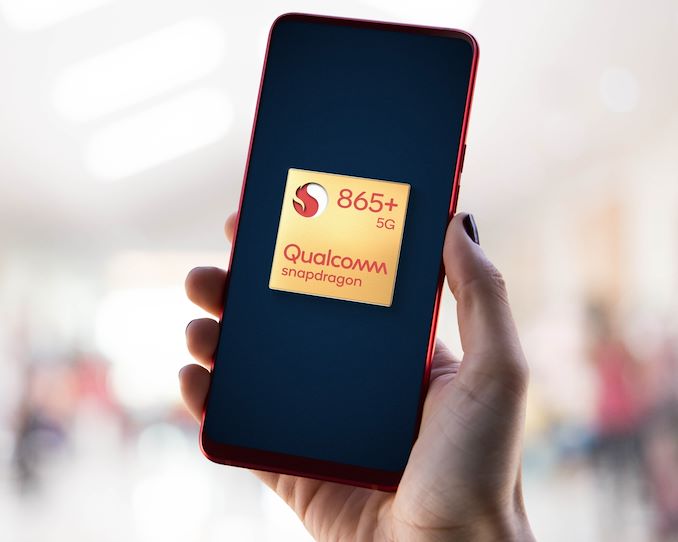Qualcomm Announces Snapdragon 865+: Breaking the 3GHz Threshold
by Andrei Frumusanu on July 8, 2020 9:30 AM EST- Posted in
- Mobile
- Qualcomm
- SoCs
- Snapdragon 865
- future-u

Today Qualcomm is announcing an update to its extremely successful Snapdragon 865 SoC: the new Snapdragon 865+. The Snapdragon 865 had already seen tremendous success with over 140 different design wins, powering some of the best Android smartphone devices this year. We’re past the hectic spring release cycle of devices, and much like last year with the S855+, for the summer and autumn release cycle, Qualcomm is providing vendors with the option for a higher-performance binned variant of the chip, the new S865+. As a bit of a arbitrary, but also important characteristic of the new chip is that this is the first ever mobile silicon to finally pass the 3GHz frequency mark.
| Qualcomm Snapdragon Flagship SoCs 2020 | |||
| SoC | Snapdragon 865 |
Snapdragon 865+ |
|
| CPU | 1x Cortex A77 @ 2.84GHz 1x512KB pL2 3x Cortex A77 @ 2.42GHz 3x256KB pL2 4x Cortex A55 @ 1.80GHz 4x128KB pL2 4MB sL3 @ ?MHz |
1x Cortex A77 @ 3.1GHz 1x512KB pL2 3x Cortex A77 @ 2.42GHz 3x256KB pL2 4x Cortex A55 @ 1.80GHz 4x128KB pL2 4MB sL3 @ ?MHz |
|
| GPU | Adreno 650 @ 587 MHz | Adreno 650 @ ? +10% Perf |
|
| DSP / NPU | Hexagon 698 15 TOPS AI (Total CPU+GPU+HVX+Tensor) |
||
| Memory Controller |
4x 16-bit CH @ 2133MHz LPDDR4X / 33.4GB/s or @ 2750MHz LPDDR5 / 44.0GB/s 3MB system level cache |
||
| ISP/Camera | Dual 14-bit Spectra 480 ISP 1x 200MP 64MP ZSL or 2x 25MP ZSL 4K video & 64MP burst capture |
||
| Encode/ Decode |
8K30 / 4K120 10-bit H.265 Dolby Vision, HDR10+, HDR10, HLG 720p960 infinite recording |
||
| Integrated Modem | none (Paired with external X55 only) (LTE Category 24/22) DL = 2500 Mbps 7x20MHz CA, 1024-QAM UL = 316 Mbps 3x20MHz CA, 256-QAM (5G NR Sub-6 + mmWave) DL = 7000 Mbps UL = 3000 Mbps |
||
| Mfc. Process | TSMC 7nm (N7P) |
||
We’ve come to know the Snapdragon 865 quite well over the last few months, detailing the performance of the chipset in our initial benchmark articles as well as a more extensive deep-dive in our Galaxy S20 review. The new Snapdragon 865+ is a new binned variant of the same chipset with higher peak frequencies on the part of the “prime” CPU as well as the GPU, promising +10% performance on both aspects.
The First Mobile Silicon to Break Past 3GHz – 3.1GHz Even
Whilst in relative terms the new chipset’s +10% clock improvement isn’t all that earth-shattering, in absolute terms it finally allows the new Snapdragon 865+ to be the first mobile SoC to break past the 3GHz threshold, slightly exceeding that mark at a peak 3.1GHz frequency. Ever since the Cortex-A75 generation we’ve seen Arm make claims about their CPU microarchitectures achieving such high clock frequencies – however in all those years actual silicon products by vendors never really managed to quite get that close in commercial mass-production designs.
We’ve had a chat with Qualcomm’s SVP and GM of mobile business Alex Katouzian, about how Qualcomm achieved this, and fundamentally it’s a combination of aggressive physical design of the product as well as improving manufacturing yields during the product’s lifecycle. Katouzian explained that they would have been able to achieve these frequencies on the vanilla Snapdragon 865 – but they would have had a lower quantity of products being able to meet this mark due to manufacturing variations. Yield improvements during the lifecycle of the Snapdragon 865 means that the company is able to offer this higher frequency variant now.
For context, in the mobile world, usually SoC SKUs are binned not by performance (clock-frequency), but by power (voltage variations). This comes in contrast to the desktop and server world where one single silicon design is binned by different performance SKUs, varying in frequencies or even functional blocks. In a sense, Qualcomm’s 855+ and 865+ are SKUs that expand the product line in the way that usual PC silicon vendors do. Other mobile vendors such as MediaTek for example also take advantage of such product segmentation by releasing a single silicon design as multiple product SKUs.
As to what this means for the power and efficiency of the new Snapdragon 865+: There will be a power increase to reach the higher frequencies, however this will only be linear with the increased clock speed, meaning energy efficiency of the new SoC will maintain the same excellent levels of that of the Snapdragon 865, so battery life will not be affected.
More + Designs This Year
This mid-year refresh was only introduced last year with the Snapdragon 855+, and while we’ve seen some vendors opt for the upgrade in their latest device releases, uptake was rather limited, with only a few handful more prominent devices such as the ASUS ROG Phone II.
This year, Qualcomm tells us that we should be expecting more adoption for the refreshed silicon, with more design wins. Amongst the publicly announced platforms today is naturally the AUSS ROG Phone 3, with full details on the phone to follow in the next couple of weeks. Lenovo is also part of the launch partners, promising to bring to market a smartphone under the Lenovo Legion branding.
Amongst other new novelties of the Snapdragon 865+ platform is the ability for vendors to bundle with the new FastConnect 6900 Wi-Fi chips from Qualcomm, the company’s new Wi-Fi 6 chipsets with 6GHz band capability (Wi-Fi 6E).
We’re looking forward to devices with the new Snapdragon 865+ in the coming weeks and months.
Related Reading:
- Qualcomm Announces Snapdragon 855 Plus: A Higher Bin SKU
- Qualcomm Announces Snapdragon 865 and 765(G): 5G For All in 2020, All The Details
- The Snapdragon 865 Performance Preview: Setting the Stage for Flagship Android 2020
- The Samsung Galaxy S20+, S20 Ultra Exynos & Snapdragon Review: Megalomania Devices
- The Snapdragon 855 Phone Roundup: Searching for the Best Implementations











81 Comments
View All Comments
TheinsanegamerN - Friday, July 10, 2020 - link
You're right, I thought it was 2015. Still it's nearly 4 years old with constant use and is holding up really well.Fritzkier - Wednesday, July 8, 2020 - link
Yeah, I really don't understand the appeal of buying flagship product if what you want is better battery life.Many mid range phones have a huge battery size, especially Xiaomi and Samsung M-series. M41 even include 7000mah battery, and that's pretty huge.
TheinsanegamerN - Friday, July 10, 2020 - link
Samsung M series and Xaiomi are sadly not sold in the US' backwards mobile marketplace.tuxRoller - Wednesday, July 8, 2020 - link
My pockets aren't large enough for my desktop or even my laptop.Come back when you can mention any positive, for consumers, effects that "sealed" designs offer.
dotjaz - Wednesday, July 8, 2020 - link
What the heck are you talking about? Batteries are replaceable. Go to any service centre and they'll do it for a fee, or even free depending on the circumstances. Removable batteries are risky especially with superfast charge that goes up to 65W. If you want removable battery, you'd be stuck with no more than 10W and a smaller battery.You'd be insane to want that just so you can avoid paying $50 (plus cost of battery which is what you're going to pay regardless) after 1.5-2 years of use.
MrVibrato - Thursday, July 9, 2020 - link
I am curious. Why would making a battery removable limit recharging power to 10W?In other words, why would it be unfeasible to have a battery that can be fast-charged with 65W _and_ is removable?
ikjadoon - Wednesday, July 8, 2020 - link
>As to what this means for the power and efficiency of the new Snapdragon 865+: There will be a power increase to reach the higher frequencies, however this will only be linear with the increased clock speed, meaning energy efficiency of the new SoC will maintain the same excellent levels of that of the Snapdragon 865, **so battery life will not be affected.**One more time now? A linear power increase is still a power increase.
2 W to 2 GHz
3 W to 3 GHz
Power draw goes up, battery life goes down. Unless this paragraph is missing key qualifiers, e.g.,, "and Qualcomm has increased efficiency elsewhere, so 865+ will maintain the same power draw as 865 even with an increased peak clock and increased peak CPU power draw."
It may be a *smaller* increase in power draw, but any increase in power draw not offset somewhere else = lower expected battery life of the 865+ versus the 865.
Wilco1 - Wednesday, July 8, 2020 - link
If perf/Watt doesn't change as stated, the total energy for any given task remains the same. So it will use more power but it will also finish earlier. For typical use it means it becomes more responsive with the same battery life. Battery life may actually improve a bit if it sleeps for longer (due to finishing quicker) or use a lower voltage at other frequencies.Andrei Frumusanu - Wednesday, July 8, 2020 - link
As Wilco explained, power draw != energy usage. The 865+ will use more power than the 865, however the energy usage for a fixed workload task will be the same. Battery life on a phone will not change as long as you're doing the same tasks.deltaFx2 - Wednesday, July 8, 2020 - link
This is true, but from the battery's POV, discharge rate matters. Higher the discharge current, the greater the reduction of battery capacity, meaning the battery provides more mAH at lower current than at higher current. I'm sure you already know this. Not a battery expert but my understanding is that internal resistance of the battery plays a role. Does it matter in normal usecases? Probably not enough to notice in my use case but I am a light user. It's also possible that the phone will start throttling for thermal reasons such that this scenario (sustained 3GHz) does not occur in practice.